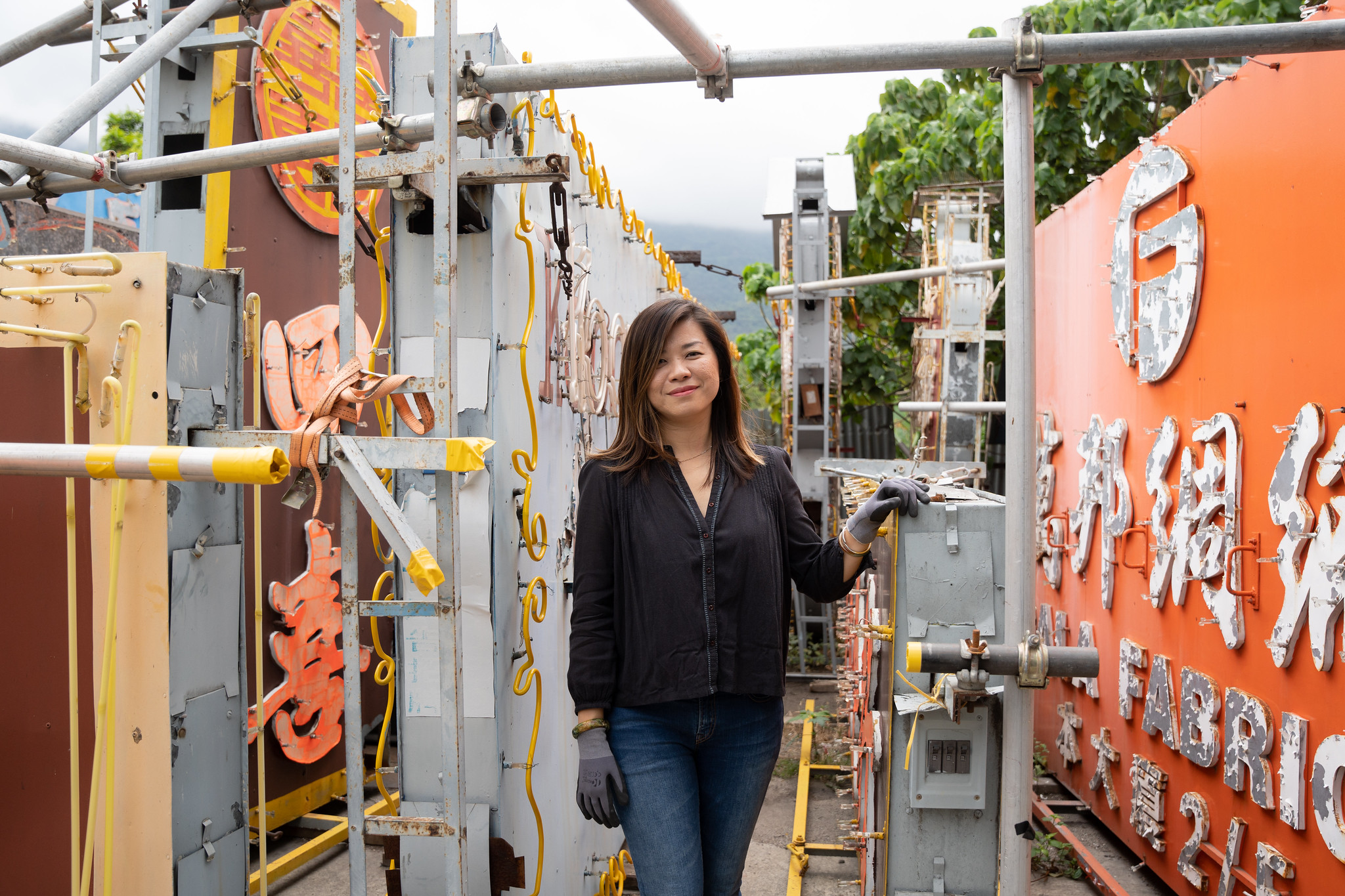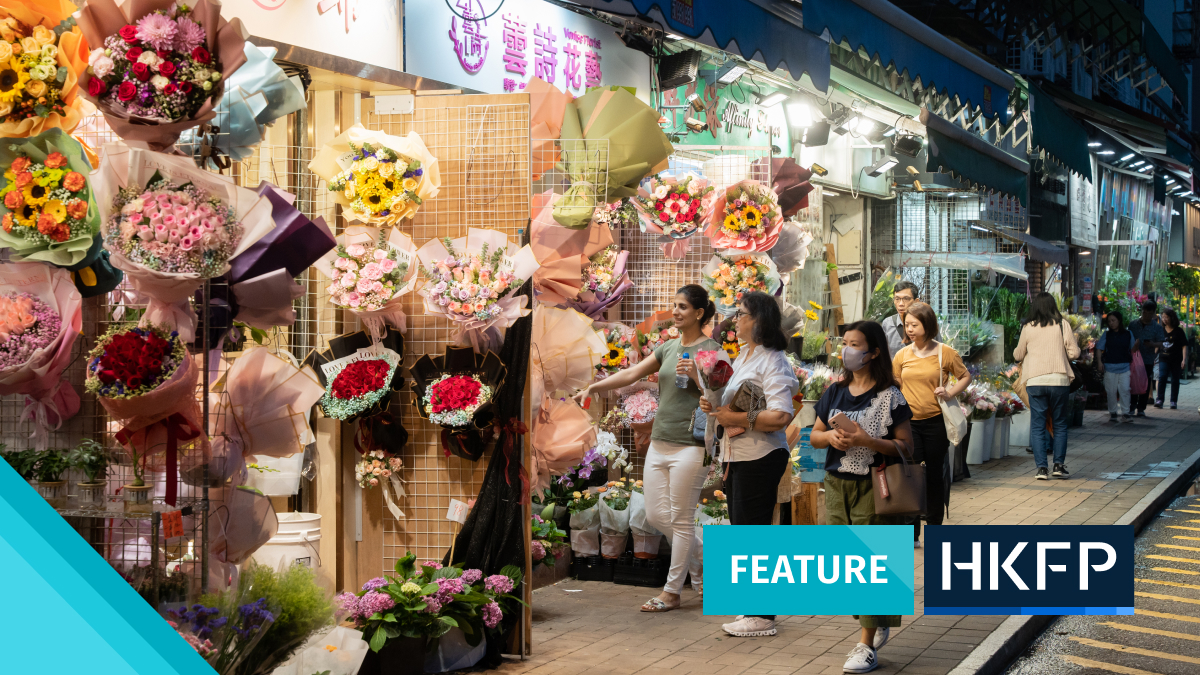Part of HKFP’s partnership with The Guardian.
The narrow pavements of Hong Kong commercial district Wan Chai are no stranger to the lunchtime rush, with queues spilling out from restaurants and promoters being ignored as they push flyers on passers-by. But on an otherwise unexceptional Monday in March, one main thoroughfare saw more commotion than usual.

Metres behind a bus stop on Hennessy Road, a crane truck pulled into a “no stopping” zone, where two neon signs – measuring around three metres tall – rested on a metal trolley. Workers deftly hooked a rope to them and, one by one, the signs were lifted onto the truck and driven off into the distance.

For Cardin Chan, this was just another day at the office as the general manager of Tetra Neon Exchange, a non-profit collecting Hong Kong’s neon signs as they are taken down.
Due to tightened government regulations, neon signs that for decades have hung outside bakeries, clothing shops and restaurants have been ordered to be removed – stripping the streets of their once-familiar glow.
There is no authoritative figure of how many neon signboards remain. The Buildings Department, which oversees building codes and safety, told HKFP that in 2011 there were about 120,000 signboards, but added that it did not keep statistics on the number of neon signs in Hong Kong. Chan said her team put the number at 400 last year when freelancers visited a number of districts to count, but the survey was ultimately unfinished.
“We’ve been notified to deal with sign removals more often recently,” she said. “I’m not too sure if they’re just receiving notices from [the government] at the same time, or if our organisation is becoming more well known, so people inform us quicker,” she added.
“We’re under the impression that more signs are coming down quicker.”

Tetra Neon Exchange has collected close to 10 neon signs in 2023 alone. Since it was founded in 2020, the non-profit has received almost 60 signs, storing most of them at a lot in a rural part of Yuen Long in the New Territories. There, signboards – some with their neon glass tubes still fixed, others with them detached for better protection – are raised atop wooden planks to prevent them from being damaged by potential flooding.

The number of removal orders for overhanging signboards – including but not exclusively neon signs – issued by the Buildings Department has increased over the past years, with 1,119 orders last year compared to below 700 in 2015.
Businesses generally have 60 days to remove their signboard after receiving the order, the department told HKFP.
Fading lights
Hong Kong’s neon lights saw their heyday in the second half of the 20th century as the economy prospered. The signs were not limited to big brands or major department stores – family-run businesses also installed them.
“Traditionally, shop owners wanted their businesses to be passed on through the generations,” Chan said. “They invested a lot in getting a sign commissioned because, to them, a sign carries the soul of a business.”
Essentially a form of advertising, these signs were so ubiquitous that neon-drenched streetscapes became an iconic symbol of the city, lending a cyberpunk backdrop to Hollywood blockbusters from Blade Runner to Ghost in the Shell.
But, in 2010, the government began issuing “very tight policies for removing unauthorised neon signs,” Brian Kwok, an Associate Professor at the Hong Kong Polytechnic University’s School of Design, said.
Since then, scores of signboards have been deemed illegal. Owners informed that their signboards are unauthorised can remove the signboard and install a new one, or apply to have it retrospectively approved under the Signboard Validation Scheme.

But the procedures are cumbersome and the associated costs can be prohibitive, Kwok said. Business owners must submit extensive paperwork documenting the signboard’s specifications and arrange inspections by a government-recognised contractor every five years.
The Buildings Department received 932 applications for signboard validation between 2013 and 2022, less than half of which were approved.
“A lot of owners would rather just take the signs down,” Kwok said, adding that they may replace them with LED signs which are “cheaper and [capable of] presenting information in a more colourful way.”

Chan said that of the cases Tetra Neon Exchange has dealt with, less than half of the business owners who removed their signboards erected new neon signs. In some cases, the signs are undoubtedly gone for good as the business owners are retiring.

Wu Chi-kai, a veteran neon craftsman, has been working in the industry for almost four decades. Standing before a messy desk in his one-man workshop, the 56-year-old demonstrated how neon signs were made. First, he heated a thin glass tube over a flame, rendering it malleable enough to be bent into shape. Once satisfied, he blew into the tube to prevent its walls from caving in.
Depending on desired glow, he might use a clear glass tube or a colour-coated one. The type of gas the tubes are filled with also determines the colour – neon gives off a red hue, while argon emits a blue glow.
The glass tubes would then be affixed to a signboard – although it has been over 20 years since Wu last worked on one. Now, he mostly receives small, sporadic assignments such as office decor or display cases for exhibitions.


With not much to keep him occupied, his days pass slowly. “I guess there are maybe eight or nine neon masters left in Hong Kong,” Wu said.
Still glowing strong
Hong Kong’s disappearing neon signs, however, have put a spotlight on the fading craft.
Kwok said he has observed more conservation efforts and local media coverage of the city’s neon signs in recent years. There is also an ongoing neon signboard exhibition at M+, a contemporary art museum said to be one of the largest in the world.

And for some businesses ordered to remove their signs, the lights are not out for good. A number have installed new neon signs, albeit more modestly sized and not extending as far into the street.
Tai Ping Koon Restaurant, an eatery with over 150 years of history, took down the neon sign outside its Tsim Sha Tsui branch in February. It has since been replaced with another featuring the same iconic design.

“The new sign is about one-third smaller,” Andrew Chui, the brand’s managing director, said. “Even though [making a new one is] expensive, our sign is very special and has appeared in a lot of old photos and music videos. So we want to preserve it.”

The new sign, Chui added, was made partially in Hong Kong and the Chinese manufacturing hub of Shenzhen.
Koon Nam Wah Bridal and Tak Cheong Noodle Shop, both of which removed their signs in the past two years, have also installed new ones. Another business that took its sign down in December, Tai Tong Bakery, told HKFP it had submitted an application to the government for a new sign. But it was exploring ways to make the sign cheaper, and reviewing the company’s finances, before making the decision.
Chan, of Tetra Neon Exchange, hesitated to say Hong Kong’s neon industry was “in demise.”
“I think neon still stands a chance in the city,” she said. “But I also want people to realise a sense of urgency. It’s really disappearing very fast, and if we don’t take the right action right now, it would disappear for good.”
Support HKFP | Policies & Ethics | Error/typo? | Contact Us | Newsletter | Transparency & Annual Report | Apps
Help safeguard press freedom & keep HKFP free for all readers by supporting our team

Original reporting on HKFP is backed by our monthly contributors.
Almost 1,000 monthly donors make HKFP possible. Each contributes an average of HK$200/month to support our award-winning original reporting, keeping the city’s only independent English-language outlet free-to-access for all. Three reasons to join us:
- 🔎 Transparent & efficient: As a non-profit, we are externally audited each year, publishing our income/outgoings annually, as the city’s most transparent news outlet.
- 🔒 Accurate & accountable: Our reporting is governed by a comprehensive Ethics Code. We are 100% independent, and not answerable to any tycoon, mainland owners or shareholders. Check out our latest Annual Report, and help support press freedom.
- 💰 It’s fast, secure & easy: We accept most payment methods – cancel anytime, and receive a free tote bag and pen if you contribute HK$150/month or more.
MORE Original Reporting
HKFP has an impartial stance, transparent funding, and balanced coverage guided by an Ethics Code and Corrections Policy.
Support press freedom & help us surpass 1,000 monthly Patrons: 100% independent, governed by an ethics code & not-for-profit.


















